nalco group
bone, muscle & joint pain physio
BOOK NOW / WHATSAPP ABOUT YOUR PAIN OR INJURY
- NOVENA 10 Sinaran Drive, Novena Medical Center #10-09, Singapore 307506
- TAMPINES 9 Tampines Grande #01-20 Singapore 528735
- SERANGOON 265 Serangoon Central Drive #04-269 Singapore 550265
Ligament Sprains

A ligament sprain is a joint-related injury, usually caused by the ligament inside being over-stretch beyond what its normal capacity, hence it is an over-stretch injury. And this type of ligament sprain or ligament injury can happen to muscles too, but it'd be called a "muscle strain" when the muscle is over-stretched (examples being neck strain and back strains).
Most of the time, sprains happen in the ligaments of our ankles and wrists. The reason for this is because of
- type of joint: our ankles and wrists have most movements (including shoulder joint)
- location: most weights and loads go through our wrists and ankles first
If the ligament or muscle is badly over-stretched or even ruptured, the patient may unfortunately have to have the particular injured area immobilized by plaster cast or customized thermoplastic splinting; or even undergo corrective surgery.
Our human ligaments are very tough, rope-like fibrous bands and their main job is to connect bones to bones, hence they're very strong.
Ligament Sprains Symptoms
- Pain and tenderness
- Swelling (patient may experience warmed/heat at injured ligament sites)
- Bruising (blue-blacks)
- Difficulty and poor strength to move the sprained limb
- If the ligament ruptured, you may hear a "pop" or a snap
Ligament Sprains Classifications
- First degree sprain - mild injury whereby there is tears of only a few fibers of the ligament
- Second degree sprain - moderate tears of part of a ligament, from 10 - 90%+ fibers
- Third degree sprain - is a complete, 90 - 100% tear of the entire ligament

Ligament Sprains Diagnosis
When a patient first sustains an injury and the doctor suspects a ligament sprain, the doctor will first start with physical and manual examination. This means that they will palpate your injured site, and move it a little (gently) and especially when they had ruled out fractures.
Then they usually will request for an x-ray scan to be done to done (if not done already) and they will check the alignment of the joint (and presence of any fractures). If the x-ray is unclear on ligament sprain, the doctor may refer you for an MRI scan.
Ligament Sprains Main Causes
The main and most common reasons why ligament sprains happen is because/when our ligament is overly stretched/extended, and that happens in traumatic or accidental events such as
- car/motor vehicle accidents
- sports and activities
- falls
common ligament sprains
- Ankle sprains
are one of the most commonly treated injuries in our physio clinic (it is one of the most common joint sprains, other than wrist sprains and back pains). Unfortunately severe and serious ankle sprains can be much more painful and taking a lot more time to rehab and recover compared to simple fractures.
- Knee sprains are also fairly common, and the most common one anterior
cruciate ligament (ACL) sprain. Knee sprains commonly occur in sporting events and athletics such as badminton, ballet, dancing, American football, football, basketball, netball, softball,
martial arts etc
- Finger sprains happens very commonly when the finger gets hooked/stuck and the object or person moves. If it's very severe, it can lead to finger dislocations or finger fractures too.
- Wrist sprains are as common as ankle sprains and they are as easily injury just by carrying a load in an awkward angle (be it weight lifting, grocery bag) or even awkward angle from using a keyboard, steering wheel etc.
ligament sprains Risk factors to consider
There are risk factors that increases the risk of ligament sprains:
- Pre-existing (previous) history eg ligaments that have been weakened due to previous sprain (such as in the case of recurrent ankle sprains)
- Muscle fatigue/insufficient break time usually leads to sprains
- Medical/health conditions that causes weaker ligaments such as Mafan syndrome
- Overtraining/too fast transitioning from a sedentary lifestyle to an active one
ligament sprain Physiotherapy treatment

If the ligament sprain is very acute/fresh, the most important is to apply the RICE method (required to be done within 72 hours of any acute injuries). RICE stands for:
- REST - the ligament that has been sprained needs rest. Better if it's immobilized and protected in a customized splint and not allowed for any additional force
- ICE
- applying cold therapy immediately to the ligament sprain to reduce swelling and pain experienced. Applied
for a max of 10-15 minutes per session and not more, as more can cause cellular damage.
- COMPRESS - you can do this in conjunction with cold therapy as mentioned above, or you can use compressive bandages/stocking/garment, depending on which is more easily applied. Please ensure that any compression done should not cut off blood flow/circulation.
- ELEVATE - raising the sprained joint higher than your heart level will help to improve venous return, decreasing swelling and pain (hastening healing as well)
We need to pay careful attention to the management of pain and swelling because swelling is good in the sense it helps with healing, but if unmanaged it can lead to a lot of joint stiffness and stiff-related pains and weaknesses.
Once edema and swelling physiotherapy is under control, and the ligament is medically stable, then our senior physiotherapists can start active physiotherapy.
- We will start with gentle active range of motion exercises to improve movement, decrease stiffness. Where applicable, we may also start passive range-of-motion stretching to stretch the joint
- We may use ultrasound therapy to accelerate ligamental (and any other damaged soft tissue) healing
- As your ligament stabilizes further, we will start working on strengthening and stamina-based exercises
This will continue until we have achieved 100% recovery.
